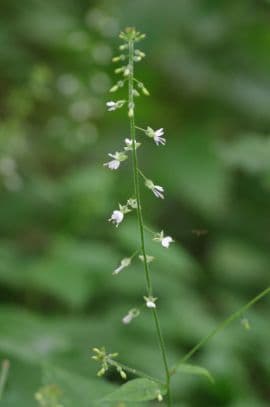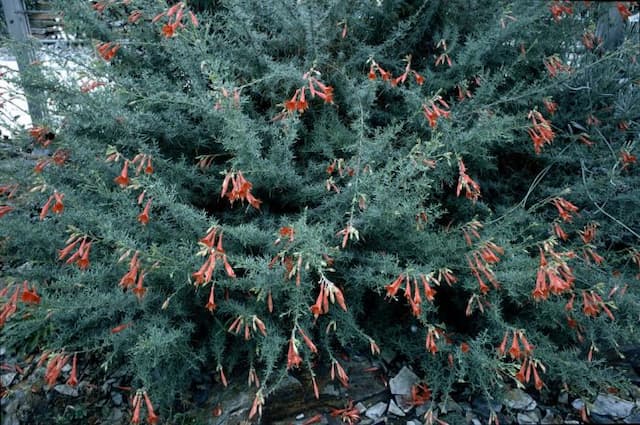Fuchsia Fuchsia 'Border Queen'

ABOUT
The Fuchsia 'Border Queen' is a particularly attractive plant that features a graceful, bushy appearance with arching branches. It is adorned with striking flowers that have a classic fuchsia shape, which consists of a combination of hanging, tube-like structures and skirt-like petals. The blossoms exhibit a delightful blend of colors, with the outer petals often displaying a deep pink to purple hue, while the inner skirt may be a lighter shade of pink or sometimes even white. These contrasting layers of color give fuchsia flowers their signature bi-color look. Delicate green leaves, which are ovate-shaped with a slightly serrated edge, cover the branches of the Fuchsia 'Border Queen'. The leaves may have a subtle veining pattern that is often less noticeable amidst the vibrant displays of flowers. These leaves are arranged oppositely along the plant’s stems, creating a lush and full appearance. The stems themselves tend to be somewhat thin, and without proper support, they may droop under the weight of the flowers and leaves, adding to the plant's pendulous charm. Throughout its blooming period, the Fuchsia 'Border Queen' can be quite a show-stopper, bringing an air of elegance and vivid color to the space it occupies. The abundance of flowers dangles from the stems like delicate earrings, making it highly attractive to hummingbirds and garden visitors alike. The intriguing shape and coloration of its blooms make the Fuchsia 'Border Queen' a favorite for those who wish to add a touch of visual drama to their garden or landscape without the need to consider its growth dimensions.
About this plant
 Names
NamesFamily
Onagraceae
Synonyms
Lady's Eardrops, Fairy Bells
Common names
Fuchsia 'Border Queen'.
 Toxicity
ToxicityTo humans
Fuchsia 'Border Queen', commonly known as Fuchsia, is generally considered non-toxic to humans. Therefore, ingesting parts of this plant typically does not lead to serious poisoning or severe symptoms. However, as with any plant, individual sensitivities vary, and consuming plant material may cause mild gastrointestinal discomfort for some people. It is always advisable to exercise caution and prevent ingestion, especially in children, as reactions can be unpredictable.
To pets
Fuchsia 'Border Queen', commonly known as Fuchsia, is not known to be toxic to pets such as dogs and cats. Ingesting parts of this plant should not cause any serious toxicity or severe symptoms. However, some pets may experience mild gastrointestinal upset if they consume the plant in significant amounts. As with any non-food plant material, watching pets closely and preventing them from eating your Fuchsia is wise to avoid any potential upset.
 Characteristics
CharacteristicsLife cycle
Perennials
Foliage type
Deciduous
Color of leaves
Green
Flower color
Mixed
Height
2 feet (60 cm)
Spread
2 feet (60 cm)
Plant type
Shrub
Hardiness zones
9
Native area
Central America
Benefits
 General Benefits
General Benefits```html
- Attracts Pollinators: Fuchsia is known to attract bees, butterflies, and hummingbirds which help in pollination.
- Ornamental Value: With its striking two-tone flowers, Fuchsia adds aesthetic value to gardens and landscapes.
- Shade Tolerance: Fuchsia can thrive in partial shade, making it suitable for garden spots that don’t receive full sun.
- Easy to Propagate: It can be easily propagated from cuttings, allowing gardeners to create more plants for use in various locations.
- Versatility: Fuchsia is suitable for planting in beds, borders, and containers, offering flexibility in garden design.
- Long Flowering Period: It has a lengthy blooming period, providing color and interest throughout the growing season.
- Cool Climate Adaptation: Fuchsia is particularly suited to cooler climates and performs well in temperate regions.
 Medical Properties
Medical PropertiesThis plant is not used for medical purposes.
 Air-purifying Qualities
Air-purifying QualitiesThis plant is not specifically known for air purifying qualities.
 Other Uses
Other Uses- Fuchsia 'Border Queen' can be used in fairy gardens due to its delicate blooms and bright colors, adding a magical touch to these miniature landscapes.
- The flowers of the Fuchsia can serve as natural dyes for fabrics or art projects, imparting subtle hues derived from their petals.
- With careful training and pruning, Fuchsia 'Border Queen' can be shaped into living sculptures or topiaries for ornamental garden displays.
- Suspensions of Fuchsia flowers can be frozen into ice cubes to add an elegant and colorful touch to summer drinks or punch bowls.
- Insect-friendly gardens benefit from Fuchsia 'Border Queen' as they attract pollinators like hummingbirds and bees, fostering biodiversity.
- The plant can be used in educational settings, such as schools, to teach students about plant biology, hybridization, and gardening skills.
- Plant enthusiasts may use the distinctive blooms of Fuchsia in photography or botanical illustration, capturing the complex shapes and vibrant colors.
- Fuchsia 'Border Queen' can be a source of inspiration for designers and artists, influencing patterns or color palettes in textiles and artworks.
- During special events such as weddings, the flowers of the Fuchsia can be utilized in creating natural, biodegradable confetti.
- The plant's pendulous flowers can be incorporated into wind chimes or mobiles for a touch of color and movement in outdoor living spaces.
Interesting Facts
 Feng Shui
Feng ShuiFuchsia is not used in Feng Shui practice.
 Zodiac Sign Compitability
Zodiac Sign CompitabilityFuchsia is not used in astrology practice.
 Plant Symbolism
Plant Symbolism- Elegance - The Fuchsia 'Border Queen' is known for its elegant and pendulous teardrop flowers, often symbolizing grace and sophistication.
- Good Taste - With its striking color combination and graceful appearance, the fuchsia flower is often associated with having good taste and preference for refined beauty.
- Confiding Love - Historically, the fuchsia flower is linked to amorous feelings and has been given as a symbol of confiding love.
- Trust - The enduring nature of the fuchsia plant, along with its harmonious color blend, may represent trust and confidence within relationships.
- Warning - In the Victorian language of flowers, fuchsia could also indicate a warning of some kind, cautioning the receiver to remain discreet or to consider a situation more carefully.
 Water
WaterFuchsias, including the 'Border Queen', should be watered regularly to keep the soil moist but not waterlogged. Generally, this plant needs to be watered once or twice a week, depending on climate conditions. During hot weather or when the plant is actively growing, you may need to water more frequently, making sure that the top inch of soil is consistently moist. It's best to water deeply, providing about 1 gallon of water per watering session for a standard-sized plant. In colder months or when the plant is dormant, reduce watering to prevent root rot.
 Light
LightThe Fuchsia 'Border Queen' thrives in bright, indirect light and should be protected from the harsh midday sun. A spot that offers morning or late afternoon sun followed by shade or dappled light during the rest of the day is ideal. Avoid direct sunlight during the hottest part of the day, as it can scorch the leaves and flowers of the plant.
 Temperature
TemperatureFuchsias, including the 'Border Queen', prefer cooler temperatures and do not tolerate extreme heat well. The ideal temperature range is between 60°F and 70°F. They can survive in temperatures as low as 40°F and as high as 80°F, but prolonged exposure outside this range can be harmful. Ensure the plant is protected from frost and extreme heat, which could be detrimental to its growth.
 Pruning
PruningPruning the Fuchsia 'Border Queen' is essential to promote bushier growth and more flowers. Prune lightly throughout the growing season to remove dead or damaged branches and spent flowers. A more thorough pruning should be done in late winter or early spring, before new growth begins. Aim to prune about one-third of the plant to maintain its shape and encourage vigorous new growth. The best time for substantial pruning is just before the plant resumes its active growth.
 Cleaning
CleaningAs needed
 Soil
SoilFuchsia 'Border Queen' thrives in a soil mix that is rich, moist, and well-draining. A good mix includes loam, peat moss, and sand or perlite to ensure adequate drainage. The best pH for the soil should be slightly acidic, ideally between 6.0 and 7.0.
 Repotting
RepottingFuchsias should generally be repotted every year or two, ideally in the spring before new growth begins. Fuchsia 'Border Queen' will benefit from this practice to refresh the soil and provide room for root growth.
 Humidity & Misting
Humidity & MistingFuchsia 'Border Queen' prefers high humidity levels, ideally between 60% and 70%. Consistently high humidity helps support its growth and flower production.
 Suitable locations
Suitable locationsIndoor
Place the Fuchsia 'Border Queen' in bright, indirect light and maintain high humidity.
Outdoor
Keep the Fuchsia 'Border Queen' in partial shade and protect from strong winds.
Hardiness zone
7-10 USDA
 Life cycle
Life cycleThe life of Fuchsia 'Border Queen', commonly referred to as hardy fuchsia, begins with seed germination, where the plant emerges from tiny seeds given the right conditions of warmth and moisture. It then enters a vegetative state where it develops roots, stems, and broad lance-shaped leaves through photosynthesis and rapid cell growth. As the plant matures, it begins to flower, producing its distinctive pendent flowers with a combination of pink, purple, and white hues which are pollinated by hummingbirds and insects. After pollination, it sets fruit in the form of small dark berries that contain seeds for the next generation. The plant goes into a dormant phase during colder months if it is situated in a region subject to frost where it loses most of its leaves, in preparation for surviving the winter. In spring, it re-emerges from dormancy, resuming growth from the existing root system and completing the cycle as it begins to grow and flower again.
 Propogation
PropogationPropogation time
Spring-Summer
Fuchsia 'Border Queen', commonly known as hardy fuchsia, is best propagated through softwood cuttings during late spring to early summer. This method entails selecting healthy, non-flowering shoots from the current year's growth. A cutting about 4 to 6 inches long is snipped just below a leaf joint or node, and the lower leaves are removed. The stem end is then dipped in rooting hormone to encourage root development and planted in a moist, well-draining potting mix. The pot is placed in a warm, bright location out of direct sunlight and covered with a plastic bag or placed in a propagator to maintain high humidity around the cutting. Roots typically develop within three to four weeks, after which the new fuchsia 'Border Queen' can eventually be transplanted outdoors once it has grown strong enough and the risk of frost has passed.









![Fuchsia [Electric Lights]](/_next/image?url=https%3A%2F%2Fplants-admin.emdemapps.com%2Fimages%2Fplants%2F%2Fimages%2F604b5ba9b6455.png&w=640&q=75)